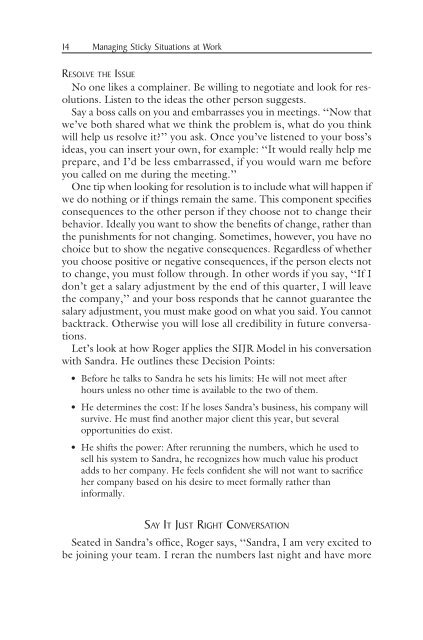Managing Sticky Situations at Work
Managing Sticky Situations at Work
Managing Sticky Situations at Work
You also want an ePaper? Increase the reach of your titles
YUMPU automatically turns print PDFs into web optimized ePapers that Google loves.
14 <strong>Managing</strong> <strong>Sticky</strong> <strong>Situ<strong>at</strong>ions</strong> <strong>at</strong> <strong>Work</strong>RESOLVE THE ISSUENo one likes a complainer. Be willing to negoti<strong>at</strong>e and look for resolutions.Listen to the ideas the other person suggests.Say a boss calls on you and embarrasses you in meetings. ‘‘Now th<strong>at</strong>we’ve both shared wh<strong>at</strong> we think the problem is, wh<strong>at</strong> do you thinkwill help us resolve it?’’ you ask. Once you’ve listened to your boss’sideas, you can insert your own, for example: ‘‘It would really help meprepare, and I’d be less embarrassed, if you would warn me beforeyou called on me during the meeting.’’One tip when looking for resolution is to include wh<strong>at</strong> will happen ifwe do nothing or if things remain the same. This component specifiesconsequences to the other person if they choose not to change theirbehavior. Ideally you want to show the benefits of change, r<strong>at</strong>her thanthe punishments for not changing. Sometimes, however, you have nochoice but to show the neg<strong>at</strong>ive consequences. Regardless of whetheryou choose positive or neg<strong>at</strong>ive consequences, if the person elects notto change, you must follow through. In other words if you say, ‘‘If Idon’t get a salary adjustment by the end of this quarter, I will leavethe company,’’ and your boss responds th<strong>at</strong> he cannot guarantee thesalary adjustment, you must make good on wh<strong>at</strong> you said. You cannotbacktrack. Otherwise you will lose all credibility in future convers<strong>at</strong>ions.Let’s look <strong>at</strong> how Roger applies the SIJR Model in his convers<strong>at</strong>ionwith Sandra. He outlines these Decision Points:• Before he talks to Sandra he sets his limits: He will not meet afterhours unless no other time is available to the two of them.• He determines the cost: If he loses Sandra’s business, his company willsurvive. He must find another major client this year, but severalopportunities do exist.• He shifts the power: After rerunning the numbers, which he used tosell his system to Sandra, he recognizes how much value his productadds to her company. He feels confident she will not want to sacrificeher company based on his desire to meet formally r<strong>at</strong>her thaninformally.SAY IT JUST RIGHT CONVERSATIONSe<strong>at</strong>ed in Sandra’s office, Roger says, ‘‘Sandra, I am very excited tobe joining your team. I reran the numbers last night and have more















